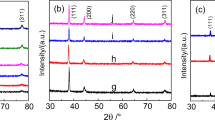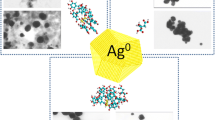Abstract
The chemical compositions, structures, and electrokinetic potentials have been studied for silver-containing Janus-type ZnO/Ag nanoparticles, heterophase Cu/Ag nanoparticles with a uniform distribution of the components over a particle, and silver-decorated TiO2 nanoparticles. The nanoparticles have been obtained by the simultaneous electric explosion of two wires. The influence of nanoparticle surface structure on the isoelectric point position and electrokinetic potential values has been analyzed. The effect of silver localization on the electrokinetic characteristics of nanoparticles has been investigated. These characteristics have been compared with those of mechanical mixtures having the same mass ratios of the components.












Similar content being viewed by others
REFERENCES
Murray, C.J., Ikuta, K.S., Sharara, F., et al., Global burden of bacterial antimicrobial resistance in 2019: A systematic analysis, Lancet, 2022, vol. 399, p. 629. https://doi.org/10.1016/S0140-6736(21)02724-0
Frei, A., Verderosa, A.D., Elliott, A.G., et al., Metals to combat antimicrobial resistance, Nat. Rev. Chem., 2023, vol. 7, p. 202. https://doi.org/10.1038/s41570-023-00463-4
Arora, N., Thangavelu, K., and Karanikolos, G.N., Bimetallic nanoparticles for antimicrobial applications, Front. Chem., 2020, vol. 8, p. 412. https://doi.org/10.3389/fchem.2020.00412
Padilla-Cruz, A.L., Garza-Cervantes, J.A., Vasto-Anzaldo, X.G., et al., Synthesis and design of Ag–Fe bimetallic nanoparticles as antimicrobial synergistic combination therapies against clinically relevant pathogens, Sci. Rep., 2021, vol. 11, no. 1, p. 1. https://doi.org/10.1038/s41598-021-84768-8
Akter, M., Sikder, M.T., Rahman, M.M., et al., A systematic review on silver nanoparticles-induced cytotoxicity: Physicochemical properties and perspectives, J. Adv. Res., 2017, vol. 2, no. 9, p. 1. https://doi.org/10.1016/j.jare.2017.10.008
Chen, M., Shou, Z., **, X., et al., Emerging strategies in nanotechnology to treat respiratory tract infections: Realizing current trends for future clinical perspectives, Drug Delivery, 2022, vol. 29, no. 1, p. 2442. https://doi.org/10.1080/10717544.2022.2089294
Ferrando, R., Jellinek, J., and Johnston, R.L., Nanoalloys: From theory to applicalions of alloy clusters and nanoparticles, Chem. Rev., 2008, vol. 108, no. 3, p. 845. https://doi.org/10.1021/cr040090g
Nasrabadi, H.T., Abbasi, E., Davaran, S., et al., Bimetallic nanoparticles: Preparation, properties, and biomedical applications, Artif. Cells, Nanomed., Biotechnol., 2016, vol. 44, no. 1, p. 376. https://doi.org/10.3109/21691401.2014.953632
Belenov, S.V., Volochaev, V.A., Pryadchenko, V.V., et al., Phase behavior of Pt−Cu nanoparticles with different architecture upon their thermal treatment, Nanotechnol. Russ., 2017, vol. 12, p. 147. https://doi.org/10.1134/S1995078017020033
Banerjee, M., Sharma, S., Chattopadhyay, A., et al., Enhanced antibacterial activity of bimetallic gold−silver core-shell nanoparticles at low silver concentration, Nanoscale, 2011, vol. 3, no. 12, p. 5120. https://doi.org/10.1039/C1NR10703H
Alonso, A., Vigués, N., Munoz-Berbel, X., et al., Activity-tunable nanocomposites based on dissolution and in situ recrystallization of nanoparticles on ion exchange resins, RSC Advances, 2015, vol. 5, no. 109, p. 89971. https://doi.org/10.1039/C5RA16081B
Ferreira, L., Guedes, J.F., Almeida-Aguiar, C., et al., Microbial growth inhibition caused by Zn/Ag−Y zeolite materials with different amounts of silver, Colloids Surf. B, 2016, vol. 142, p. 141. https://doi.org/10.1016/j.colsurfb.2016.02.042
Markova, Z., Šišková, K.M., Filip, J., et al., Air stable magnetic bimetallic Fe−Ag nanoparticles for advanced antimicrobial treatment and phosphorus removal, Environ. Sci. Technol., 2013, vol. 47, no. 10, p. 5285. https://doi.org/10.1021/es304693g
Taner, M., Sayar, N., Yulug, I.G., et al., Synthesis, characterization and antibacterial investigation of silver−copper nanoalloys, J. Mater. Chem., 2011, vol. 21, no. 35, p. 13150. https://doi.org/10.1039/C1JM11718A
Gupta, A., Mumtaz, S., Li, C.H., et al., Combatting antibiotic-resistant bacteria using nanomaterials, Chem. Soc. Rev., 2019, vol. 48, no. 2, p. 415. https://doi.org/10.1039/C7CS00748E
Rajchakit, U. and Saro**i, V., Recent developments in antimicrobial-peptide-conjugated gold nanoparticles, Bioconjugate Chem., 2017, vol. 28, no. 11, p. 2673. https://doi.org/10.1021/acs.bioconjchem.7b00368
Bukina, Yu.A. and Sergeeva, E.A., Antibacterial properties and mechanism of bactericidal action of silver nanoparticles and ions, Vestn. Kazan. Tekhnol. Univ., 2012, vol. 15, no. 14, p. 170.
Pillai, P., Kowalczyk, P.B., Kandere-Grzybowska, K., et al., Engineering gram selectivity of mixed-charge gold nanoparticles by tuning the balance of surface charges, Angew. Chem., Int. Ed., 2016, vol. 55, no. 30, p. 8610. https://doi.org/10.1002/anie.201602965
Huo, S., Jiang, Y., Gupta, A., et al., Fully zwitterionic nanoparticle antimicrobial agents through tuning of core size and ligand structure, ACS Nano, 2016, vol. 10, no. 9, p. 8732. https://doi.org/10.1021/acsnano.6b04207
Krishnan, G., de Graaf, S., Gert, H., et al., Strategies to initiate and control the nucleation behavior of bimetallic nanoparticles, Nanoscale, 2017, vol. 9, no. 24, p. 8149. https://doi.org/10.1039/C7NR00916J
Langlois, C., Li, Z.I., Yuan, J., et al., Transition from core−shell to Janus chemical configuration for bimetallic nanoparticles, Nanoscale, 2012, vol. 4, no. 11, p. 3381. https://doi.org/10.1039/C2NR11954D
Bakina, O.V., Glazkova, E.A., Svarovskaya, N.V., et al., “Janus”-like Cu–Fe bimetallic nanoparticles with high antibacterial activity, Mater. Lett., 2019, vol. 242, p. 187. https://doi.org/10.1016/j.matlet.2019.01.105
Lozhkomoev, A.S., Kazantsev, S.O., Kondrano-va, A.M., et al., Design of antimicrobial composite nanoparticles ZnxMe (100–x)/O by electrical explosion of two wires in the oxygen-containing atmosphere, Mater. Des., 2019, vol. 183, p. 108099. https://doi.org/10.1016/j.matdes.2019.108099
Bakina, O.V., Glazkova, E.A., Pervikov, A.V., et al., Electric explosion of wires as versatile method for antibacterial Janus-like ZnO–Ag nanoparticles preparation, J. Mater. Sci.: Mater. Electron., 2021, vol. 32, p. 10623. https://doi.org/10.1007/s10854-021-05718-8
Bakina, O., Glazkova, E., Pervikov, A., et al., Design and preparation of silver−copper nanoalloys for antibacterial applications, Journal of Cluster Science, 2021, vol. 32, p. 779. https://doi.org/10.1007/s10876-020-01844-1
Chace, W.G., Exploding wires, Phys. Today, 1964, vol. 17, no. 8, p. 19. https://doi.org/10.1063/1.3051737
Kuznetsova, A.S., Ermakova, L.E., Antropova, T.V., et al., Chemical composition, structure, and electrokinetic potential of nickel- and iron-containing vitreous materials, Colloid J., 2021, vol. 83, no. 3, p. 335. https://doi.org/10.1134/S1061933X21030108
Balouiri, M., Sadiki, M., and Ibnsouda, S.K., Methods for in vitro evaluating antimicrobial activity: A review, J. Pharm. Anal., 2016, vol. 6, no. 2, p. 71. https://doi.org/10.1016/j.jpha.2015.11.005
Lerner, M.I., Svarovskaya, N.V., Psakhie, S.G., et al., Production technology, characteristics, and some applications of electric-explosion nanopowders of metals, Nanotechnol. Russ., 2009, vol. 4, nos. 11–12, p. 741. https://doi.org/10.1088/09574484/27/20/205603
Diagrammy sostoyaniya dvoinykh metallicheskikh system (Diagrams of the State of Binary Metallic Systems), Lyakishev, N.P., Ed., Moscow: Mashinostroenie, 1996, vol. 1.
Chudnenko, K.V. and Pal’yanova, G.A., Thermodynamic properties of solid solutions in the Ag–Au–Cu system, Geol. Geofiz., 2014, vol. 55, no. 3, p. 449.
Liu, X., Wu, Y., **e, G., et al., New green soft chemistry route to Ag–Cu bimetallic nanomaterials, Int. J. Electrochem. Sci., 2017, vol. 12, p. 3275. https://doi.org/10.20964/2017.04.61
Williamson, G.K. and Hall, W.H., X-ray line broadening from filed aluminium and wolfram, Acta Metall., 1953, vol. 1, no. 1, p. 22. https://doi.org/10.1016/0001-6160(53)90006-6
Kushwah, M., Gaur, M.S., Berlina, A.N., et al., Biosynthesis of novel Ag@Cu alloy NPs for enhancement of methylene blue photocatalytic activity and antibacterial activity, Mater. Res. Express, 2019, vol. 6, no. 11, p. 116561. https://doi.org/10.1088/2053-1591/ab485e
Ni, Z., Wan, M., Tang, G., et al., Synthesis of CuO and PAA-regulated silver-carried CuO nanosheet composites and their antibacterial properties, Polymers, 2022, vol. 14, no. 24, p. 5422. https://doi.org/10.3390/polym14245422
Kaushik, V.K., XPS core level spectra and auger parameters for some silver compounds, J. Electron Spectrosc. Relat. Phenom., 1991, vol. 56, no. 3, p. 273. https://doi.org/10.1016/0368-2048(91)85008-H
Rajendran, R. and Mani, A., Photocatalytic, antibacterial and anticancer activity of silver-doped zinc oxide nanoparticles, J. Saudi Chem. Soc., 2020, vol. 24, no. 12, p. 1010. https://doi.org/10.1016/j.jscs.2020.10.008
Parvin, T., Keerthiraj, N., Ibrahim, I.A., et al., Photocatalytic degradation of municipal wastewater and brilliant blue dye using hydrothermally synthesized surface-modified silver-doped ZnO designer particles, Int. J. Photoenergy, 2012, vol. 2012, p. 670610. https://doi.org/10.1155/2012/670610
Chan, Y.Y., Pang, Y.L., Lim, S., et al., Biosynthesized Fe-and Ag-doped ZnO nanoparticles using aqueous extract of Clitoria ternatea Linn for enhancement of sonocatalytic degradation of Congo red, Environ. Sci. Pollut. Res., 2020, vol. 27, p. 34675. https://doi.org/10.1007/s11356-019-06583-z
Azouri, A., Ge, M., Xun, K., et al., Zeta potential studies of titanium dioxide and silver nanoparticle composites in water-based colloidal suspension, Multifunctional Nanocomposites and Nanomaterials International Conference, 2008, vol. 47616, p. 221. https://doi.org/10.1115/MN2006-17072
Ren, Y., Wang, C., Chen, Z., et al., Emergent heterogeneous microenvironments in biofilms: Substratum surface heterogeneity and bacterial adhesion force-sensing, FEMS Microbiol. Rev., 2018, vol. 42, no. 3, p. 259. https://doi.org/10.1093/femsre/fuy001
Funding
The study was carried out within the framework of the state order to the Institute of Strength Physics and Materials Science, Siberian Branch, Russian Academy of Sciences, FWRW-2021-0007. The synthesis and study of TiO2/Ag nanoparticles were supported by the Russian Science Foundation, project no. 21-13-00498.
Author information
Authors and Affiliations
Corresponding author
Ethics declarations
The authors declare that they have no conflicts of interest.
Rights and permissions
About this article
Cite this article
Lerner, M.I., Bakina, O.V., Kazantsev, S.O. et al. Silver-Containing Bicomponent Nanoparticles: Relationship between Morphology and Electrokinetic Potential. Colloid J 85, 520–530 (2023). https://doi.org/10.1134/S1061933X23600422
Received:
Revised:
Accepted:
Published:
Issue Date:
DOI: https://doi.org/10.1134/S1061933X23600422




